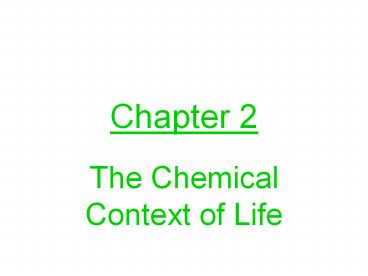The Chemical Context of Life - PowerPoint PPT Presentation
1 / 13
Title:
The Chemical Context of Life
Description:
Chapter 2 The Chemical Context of Life Matter Element -92 naturally occurring, ~ 12 more man made -symbol is Latin derived Compound -ex: NaCl Essential ... – PowerPoint PPT presentation
Number of Views:94
Avg rating:3.0/5.0
Title: The Chemical Context of Life
1
Chapter 2
- The Chemical Context of Life
2
- Matter
- Element
- -92 naturally occurring, 12 more man
- made
- -symbol is Latin derived
- Compound
- -ex NaCl
- Essential elements to living things 25 of the
92 - 96 made of C, O, H, N
- 4 P, S, Ca, K, a few others
- Trace elements
3
- Atoms
- electrons 1/2000 of proton/neutron
- (e-)
- atomic number
- number of protons (p)
- number of electrons (e-)
- 2He
- mass number
- protons neutrons (n0)
- (nucleus)
- 4He
- 2
4
- Isotope
- atoms w/ same of protons, but different
- number of neutrons
- ex 14C 12C 13C
- radioactive, unstable dont have
tendency to lose particles stable - Half life
- time it takes 50 of radioactive atoms to
- decay
5
What are radioactive isotopes used for?
- biological tracers
- fossil dating
- diagnostic tools in medicine
6
- Electrons
- potential energy due to position/relation
- to nucleus
- Energy levels (electron shells)
- different states of potential energy
- farther out absorb energy
- farther in lose energy
- Orbital
- 3D space where electron is found 90 of time
- 1s 2e-
- 2s 8e- 2n2
- 2px 2e-
- 2py 2e- 8e-
- 2pz 2e-
7
- Valence electrons
- determine chemical properties
- Octet rule
- valence shell complete with 8 electrons
- Inert
8
- Bonding
- molecule
- 2 or more atoms held together
- by chemical bonds
- ex O2 NaCl O3
9
- Covalent
- ex H2
- H-H OO N N
- valence
- bonding capacity
- electronegativity
- attraction of an atom for the electrons
- of a covalent bond
- nonpolar
- atoms are equally electroegative electrons
- shared equally ex CH4
- polar one is more electronegative not
shared equally - ex H2O
10
- Ionic
- loss/gain of e- due to electronegativity
- ex NaCl
- ion
- -electrically charged atom
- may also be groups of atoms (NH4)
- other salts are also ionic
- -break easily in water
- cation anion
11
Other weak bonds
- H bonds (IMF)
- -in covalent molecules attracted to each other
- and N or O, as in water
- van der Waals interactions
- -ever changing hot spots of or charges
- that enable all molecules atoms to stick
- together due to chance accumulation of e-
12
- 5) Hydrophobic interactions
- water fearing
- -coalesce in water to minimize exposure
- -once close together, van der Waals
- reinforces interaction
13
Chemical reactions
- -make/break bonds
- Mg 2Cl MgCl2
- reactants products
- 3H2 N2 2NH3
- (reversible reaction)
- chemical equilibrium eventually reached when
reactions offset one another (concentrations have - stabilized) not in equal concentration































